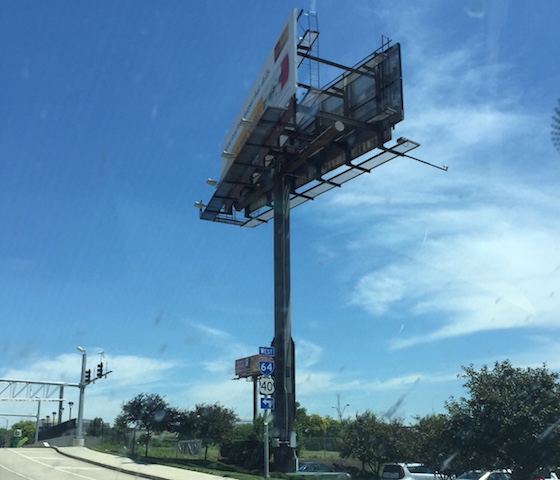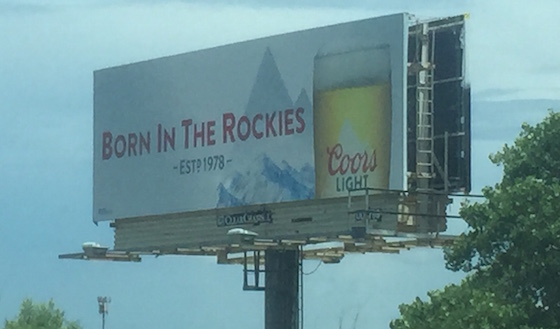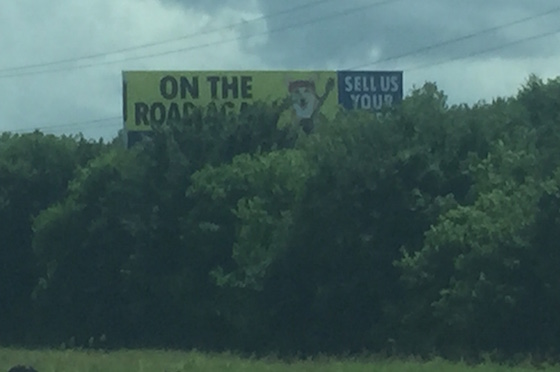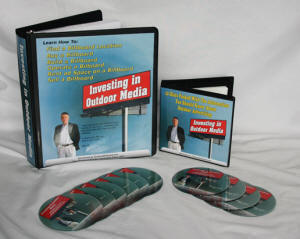Memo From Frank
I frequently get calls from people that think that the future of the billboard industry is in digital billboards. Nothing could be farther from the truth. There are roughly 500,000 billboards in the U.S., but only about 2,000 of those are digital. 99% of all billboards are the good old-fashioned variety. Successful digital signs share some traits that makes them very rarified, such as prime highways at unbelievably important intersections. They also carry huge price tags, normally around $200,000 per face or more. But that’s an incredibly tiny specialty market. The real meat and potatoes of the billboard industry is, and will remain, the classic billboard that is rented by the month, not per 8 seconds.
“V” Is For Victory – In Some Cases

Probably no topic is more shrouded in mystery when building a billboard than the use of the “V” to enhance the readability of the advertisements. Theories on the use of the “V” have been around since the first sign was built over a hundred years ago, and everyone has their own opinion. Since there are big dollars involved in the decision, you have to weigh the options. Here are my thoughts on the “V”.
The bigger the “V” the better the demand for the ad space
Just as you can never be too rich or too thin, you can also never have too much “V”. I have never, in thousands of sales calls, ever heard a customer complain “I’d rent that sign but the “V” is too big”. So it’s a given fact that, when your budget affords it, the answer always is “yes, I want to build a “V”. However, there are other considerations to temper that enthusiasm.
But the bigger the “V” the higher the price tag
The primary issue with build “V” structures is money. They are really expensive. How expensive? Try up to 100% more than a standard structure. In fact, with wooden structures they require you to build two separate structures and then join them together (so essentially twice the cost). So there’s the dilemma – do you spend the extra money or not?
Not all sign locations warrant a “V”
If you have a billboard location that allows you to build a simple back-to-back unit, then you probably should save your money and use it on something else. The key is how many feet of clear read “V”. If, however, the sign has obstructions that hit prior to the end of the 500’ read window, or the sign has “negative” read to the highway (angling away from the road bed) then you probably need a “V” to make the sign successful in attracting advertisers.
And not all “V”s are created equal
The standard “V” for a billboard is not very large – maybe 8’ in width. The concept with an 8’ “V”, however, is that you make the right-hand read perpendicular to the road, and put all of the angle on the left-hand read, which gives the same impact as a 16’ “V”. But when it comes to “v” size, the sky’s the limit. The “tri-face V” is a “V” as wide as the sign face is long (imagine a 48’ “V”). But there is a “super V” in which the “V” can be nearly 100’ wide. As long as your checkbook will accommodate it, there is virtually no limitation to how big a “V” you can build. But since it’s your checkbook, you should be very careful only to build what you need – and that means as small a “V” as fits your needs.
Some tricks you should know
But beyond choosing the right “V”, there are some other things you need to know about building “V” structures. First of all, you need to personally be there to choose the orientation of the sign to the highway. There’s no point in spending the money to build a “V” if it’s turned the wrong way. Once the sign is in the ground, it’s game over on making changes. You have to be there to make sure it’s done right. Secondly, you have to really analyze the economics of that “V” beyond just renting the ad space. If the sign is on a highway where there is little demand in one direction, and the side in question is going that wrong way, then you might prefer to keep the sign cost cheap and just forget about trying to get a little more with that “V”. It may be that the cost of the “V” is higher than the extra rent you’ll receive.
Conclusion
“V”s on signs are great – but they’re expensive. You need to understand the pros and cons of this structural enhancement and make an educated decision. “V”s are not for every sign, but they might be for yours.
The Power Of Renewal

This is my billboard that I built around 1986 and still advertises Coors Beer – 30 years later! This billboard illustrates what should be the basic goal of all sign owners: advertiser renewal. Of all the secrets of successful billboard owners, near the top of the list is the ability to select advertisers who will stay on signs for years, not months.
The job of the billboard salesman is to match the right sign to the right customer
Being a good billboard salesman is like being a matchmaker. Your job is to find the perfect advertiser for every sign. Who is the perfect advertiser? Typically a mix of a business that is located at the next exit or near to the sign, who needs the exposure due to the timing of the exit or bad road visibility, that is a stable business that has the money to pay the bills and can make a decent profit from advertising on the sign. That’s a lot to ask for, right? Well, that’s your job – to find advertisers that come as close to these qualities as you can. A typical sign has probably 10 different advertisers that would be perfect, so the odds are definitely in your favor.
High levels of renewal are primary evidence of doing a good sales job
The trait of a great billboard salesman is an extremely high rate of renewal. How high? I was able to maintain 80% renewal rates for years. But that’s still not as good as it could be – there’s always 100%. Billboard salesmen who have high rates of renewal understand that, at the end of the day, to keep an advertiser on a billboard for years they have to make a profit from advertising on the sign. If a billboard rents for $500 per month, then the successful advertiser has to feel that they made more than $500 per month of profit from it. Once you have established this metric, then the billboard becomes an asset and not a liability.
High renewal rates are the engine that drive high sales productivity
When I owned 300 billboards, it looked like an impossible mountain to climb to keep those billboards occupied. However, I was able to maintain about an 80% renewal rate. That meant that I only had to rent about 60 billboards per year, and the other 240 signs renewed year after year. Think of how that affects your workload. High rates of renewal are an essential part of having extremely high sales productivity.
Look at what high renewal rates save you
And beyond the time and energy savings, there are other tangible benefits to having high rates of renewal. The first is that you have no down-time on the billboard. For example, if you have a sign that rents for $1,000 per month, and then is vacant for two months, then having the advertiser renew would have saved you $2,000 in lost rent, plus the time and effort of finding a replacement advertiser. In addition, vacant signs look terrible to your bank, and can scare them into not advancing you further loans. There are many reasons while renewal is such a positive force in billboard operations.
Conclusion
One of the most important skills in renting billboards is finding the right advertiser for the sign. The result is renewal. And this is one of the most important drivers to profitability.
Billboard Home Study Course
![]() How to Find a Billboard Location
How to Find a Billboard Location
![]() How to Buy a Billboard
How to Buy a Billboard
![]() How to Build a Billboard
How to Build a Billboard
![]() How to Operate a Billboard
How to Operate a Billboard
![]() How to Rent Ad Space on a Billboard
How to Rent Ad Space on a Billboard
![]() How to Sell a Billboard
How to Sell a Billboard
Get Your Copy Now!
The Truth About Trees

Trees look great in your yard. Arboretums are beautiful to walk around in. Ski lodges would not be the same without acres of beautiful giant pines. But in the billboard business, trees are never an asset, only a liability. Even tree huggers get nasty when they own billboards. So what’s the truth about trees and billboards?
Trees can block signs
The problem with trees is that they block signs. As long as they are below your sign, then they are beautiful gems of nature. But once they start to block visibility of your billboard, then they are giant villains that need to be destroyed. If you added up all of the billboards that are deprived rent due to tree obstructions, the result would be in the millions of dollars.
You need to take action well before the tree grows too tall
If you have a billboard and there is the threat of the tree growing tall enough to hinder visibility, the time to act is now. You have much better negotiating posture when the sign is still clear of obstruction. In that manner, you have plenty of time to negotiate, and the impact of the tree is still somewhat in doubt. Once the sign is clearly obscured, the owner of the tree knows they have you over a barrel and will demand a much higher payment.
Vegetation maintenance agreements
The standard attack plan on trees that eat into your sign are called “vegetation maintenance agreements”. These are simple agreements that allow the billboard owner to do such periodic maintenance (typically cutting back tree limbs) as is required to keep the sign free of obstructions. Under the agreement, you pay the property owner that has the tree financial compensation, which can range from the hundreds to the thousands per year, based on the value of the sign.
Building your sign high enough to avoid the issue
Even better than vegetation maintenance agreements is simply to build the billboard higher than the trees can ever grow. Before you decide on the correct height of the billboard you are building, make sure you have properly measured how high you need to be to be above the trees both today and years into the future.
But don’t even think about doing it illegally
No matter how bad the tree obstruction on a billboard, don’t ever even think of getting out your chainsaw and cutting off the branch or tree, or poisoning it. These are felonies and can actually land you in jail. I don’t know of a billboard owner who was sent to jail, but I do now of owners who have been fined $10,000+ and forced to plant new trees back that then block their sign just it had been with the one they illegally cut down.
Conclusion
You cannot be in the billboard business and not have a run-in or two with tree blockage. It’s been a problem since the very first signs were created. But you can work around tree obstructions if you tackle them proactively.
New Billboards For Sale On OutdoorBillboard.com
The Market Report
Prices Are Delayed By At Least 15 Minutes
